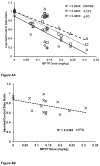Dopamine pathway loss in nucleus accumbens and ventral tegmental area predicts apathetic behavior in MPTP-lesioned monkeys
- PMID: 22579525
- PMCID: PMC3367030
- DOI: 10.1016/j.expneurol.2012.04.025
Dopamine pathway loss in nucleus accumbens and ventral tegmental area predicts apathetic behavior in MPTP-lesioned monkeys
Abstract
Apathy, primarily defined as a lack of motivation, commonly occurs in people with Parkinson disease (PD). Although dysfunction of basal ganglia pathways may contribute to apathy, the role of dopamine remains largely unknown. We investigated the role of dopaminergic pathways in the manifestation of apathetic behaviors by measuring the effects of the selective dopaminergic neurotoxin 1-methyl-4-phenyl-1,2,3,6-tetrahydropyridine (MPTP) on monkeys' willingness to attempt goal directed behaviors, distinct from their ability to perform tasks. Fifteen macaques received variable doses of MPTP, had PET scans with [(11)C]-dihydrotetrabenazine (DTBZ), [(11)C]-2β-3β-4-fluorophenyltropane (CFT), and [(18)F]-fluorodopa (FD) and performed tasks to assess apathetic behaviors and motor impairment. At 8 weeks post-MPTP, primates were euthanized and stereological cell counts and dopamine measurements were done. Apathy scores were compared to motor scores, in vitro and in vivo dopaminergic measures. Apathy scores increased following MPTP and correlated with DTBZ (r(S) = -0.85), CFT (r(S) = -0.87), and FD (r(S) = -0.85) specific uptake in nucleus accumbens (NAcc,) and dopaminergic cell counts in ventral tegmental area (VTA, r(S) = -0.80). Dopaminergic cell loss in VTA provided significant predictive power for apathy scores after controlling for the influence of cell loss in SN. Additionally, forward step-wise regression analyses indicated that neuropathological changes in the VTA-NAcc pathway predict apathetic behavior better than motor impairment or neuropathological changes in the nigrostriatal network. Our findings suggest that dopaminergic dysfunction within the VTA-NAcc pathway plays a role in the manifestation of apathetic behaviors in MPTP-lesioned primates. Similar changes in people with PD may contribute to apathy.
Copyright © 2012 Elsevier Inc. All rights reserved.
Conflict of interest statement
All authors report no financial interests or potential conflicts of interest.
Figures






References
-
- Barnhart JW, Makela EH, Latocha MJ. SSRI-induced apathy syndrome: A clinical review. J Psychiatr Pract. 2004;10:196–199. - PubMed
-
- Bechara A, Damasio H, Damasio AR. Emotion, decision making, and the orbitofrontal cortex. Cereb Cortex. 2000;10:295–307. - PubMed
-
- Bhatia KP, Marsden CD. The behavioral and motor consequences of focal lesions of the basal ganglia in man. Brain. 1994;117:859–876. - PubMed
-
- Borek LL, Amick MM, Friedman JH. Non-motor aspects of Parkinson’s disease. CNS Spectr. 2006;11:541–554. - PubMed
-
- Carmichael ST, Price JL. Sensory and premotor connections of the orbital and medial prefrontal cortex of macaque monkeys. J Comp Neurol. 1995;346:642–664. - PubMed
Publication types
MeSH terms
Grants and funding
LinkOut - more resources
Full Text Sources

